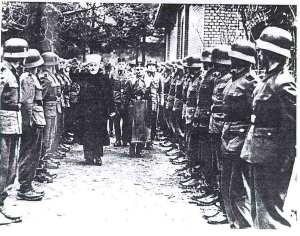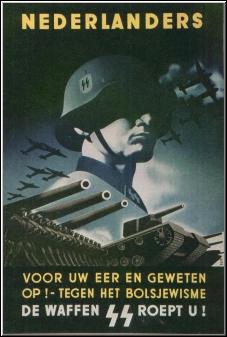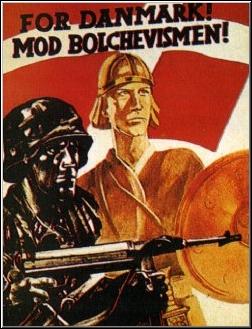
A picture taken in 1943 of the Grand Mufti of Jerusalem Haj Amin el-Husseini reviewing Bosnian-Muslim troops - a unit of the "Hanjar (Saber) Division" of the Waffen SS which he personally recruited for Hitler.
Arab leaders and media outlets have long been addicted to comparing Israel to the Nazi regime, while at the same time demeaning the extent of the Holocaust. This obsession with defaming and antagonizing the Jewish people and state was on full display in recent months and reached a crescendo – or rather nadir – the day before Pope John Paul II visited the Temple Mount during his Holy Land pilgrimage. The Grand Mufti of Jerusalem, Sheikh Ekrima Sabri, just hours before hosting the Pope, gave a series of press interviews, first telling the AP: "The figure of 6 million Jews killed during the Holocaust is exaggerated and is used by the Israelis to gain international support… It’s not my problem. Muslims didn’t do anything on this issue. It’s the doing of Hitler who hated the Jews," asserted the acid-tongued Mufti – a figure appointed by Palestinian leader Yasser Arafat. "Six million? It was a lot less," Sabri repeated for an Italian newspaper. "It’s not my fault if Hitler hated the Jews. Anyway, they hate them just about everywhere." The Mufti finished the day with Reuters, charging, "We denounce all massacres, but I don’t see why a certain massacre should be used for political gain and blackmail." However, as a matter of record, there was a well-documented, thriving relationship between the Arab/Muslim world and Nazi Germany, with perhaps the most significant figure linking Hitler to the Middle East being none other Sabri’s very own predecessor, Grand Mufti of Jerusalem Haj Amin el-Husseini. Here is a brief review of that dark, overlooked chapter in history.
The Führer’s Mufti: After World War I, the Great Powers of Europe jockeyed for influence in the Middle East’s oil fields and trade routes, with France and Britain holding mandates throughout most of the region. In the 1930s, the fascist regimes that arose in Italy and Germany sought greater stakes in the area, and began courting Arab leaders to revolt against their British and French custodians. Among their many willing accomplices was Jerusalem Mufti Haj Amin el-Husseini, who fled Palestine after agitating against the British during the Arab Revolt of 1936-39. He found refuge in Iraq – another of Her Majesty’s mandates – where he again topped the British most wanted list after helping pull the strings behind the Iraqi coup of 1941. The revolt in Baghdad was orchestrated by Hitler as part of a strategy to squeeze the region between the pincers of Rommel’s troops in North Africa, German forces in the Caucuses and pro-Nazi forces in Iraq. However, in June 1941 British troops put down the rebellion and the Mufti escaped via Tehran to Italy and eventually to Berlin.
Once in Berlin, the Mufti received an enthusiastic reception by the "Islamische Zentralinstitut" and the whole Islamic community of Germany, which welcomed him as the "Führer of the Arabic world." In an introductory speech, he called the Jews the "most fierce enemies of the Muslims" and an "ever corruptive element" in the world. Husseini soon became an honored guest of the Nazi leadership and met on several occasions with Hitler. He personally lobbied the Führer against the plan to let Jews leave Hungary, fearing they would immigrate to Palestine. He also strongly intervened when Adolf Eichman tried to cut a deal with the British government to exchange German POWs for 5000 Jewish children who also could have fled to Palestine. The Mufti’s protests with the SS were successful, as the children were sent to death camps in Poland instead. One German officer noted in his journals that the Mufti would liked to have seen the Jews "preferably all killed." On a visit to Auschwitz, he reportedly admonished the guards running the gas chambers to work more diligently. Throughout the war, he appeared regularly on German radio broadcasts to the Middle East, preaching his pro-Nazi, anti-Semitic message to the Arab masses back home.
To show gratitude towards his hosts, in 1943 the Mufti travelled several times to Bosnia, where on orders of the SS he recruited the notorious "Hanjar troopers," a special Bosnian Waffen SS company which slaugh-tered 90% of Bosnia’s Jews and burned countless Serbian churches and villages. These Bosnian Muslim recruits rapidly found favor with SS chief Heinrich Himmler, who established a special Mullah Military school in Dresden.
The only condition the Mufti set for his help was that after Hitler won the war, the entire Jewish population in Palestine should be liquidated. After the war, Husseini fled to Switzerland and from there escaped via France to Cairo, were he was warmly received. The Mufti used funds received earlier from the Hilter regime to finance the Nazi-inspired Arab Liberation Army that terrorized Jews in Palestine.
The Arab Embrace of Nazism: Husseini represents the prevalent pro-Nazi posture among the Arab/Muslim world before, during and even after the Holocaust. The Nazi-Arab connection existed even when Adolf Hitler first seized power in Germany in 1933. News of the Nazi takeover was welcomed by the Arab masses with great enthusiasm, as the first congratulatory telegrams Hitler received upon being appointed Chancellor came from the German Consul in Jerusalem, followed by those from several Arab capitals. Soon afterwards, parties that imitated the National Socialists were founded in many Arab lands, like the "Hisb-el-qaumi-el-suri" (PPS) or Social Nationalist Party in Syria. Its leader, Anton Sa’ada, styled himself the Führer of the Syrian nation, and Hitler became known as "Abu Ali" (In Egypt his name was "Muhammed Haidar"). The banner of the PPS displayed the swastika on a black-white background. Later, a Lebanese branch of the PPS – which still receives its orders from Damascus – was involved in the assassination of Lebanese President Pierre Gemayel.
The most influential party that emulated the Nazis was "Young Egypt," which was founded in October 1933. They had storm troopers, torch processions, and literal translations of Nazi slogans – like "One folk, One party, One leader." Nazi anti-Semitism was replicated, with calls to boycott Jewish businesses and physical attacks on Jews. Britain had a bitter experience with this pro-German mood in Egypt, when the official Egyptian government failed to declare war on the Wehrmacht as German troops were about to conquer Alexandria.
After the war, a member of Young Egypt named Gamal Abdul Nasser was among the officers who led the July 1952 revolution in Egypt. Their first act – following in Hitler’s footsteps – was to outlaw all other parties. Nasser’s Egypt became a safe haven for Nazi war criminals, among them the SS General in charge of the murder of Ukrainian Jewry; he became Nasser’s bodyguard and close comrade. Alois Brunner, another senior Nazi war criminal, found shelter in Damascus, where he served for many years as senior adviser to the Syrian general staff and still resides today.
Sami al-Joundi, one of the founders of the ruling Syrian Ba’ath Party, recalls: "We were racists. We admired the Nazis. We were immersed in reading Nazi literature and books... We were the first who thought of a translation of Mein Kampf. Anyone who lived in Damascus at that time was witness to the Arab inclination toward Nazism."
These leanings never completely ceased. Hitler’s Mein Kampf currently ranks sixth on the best-seller list among Palestinian Arabs. Luis Al-Haj, translator of the Arabic edition, writes glowingly in the preface about how Hitler’s "ideology" and his "theories of nationalism, dictatorship and race… are advancing especially within our Arabic States." When Palestinian police first greeted Arafat in the self-rule areas, they offered the infamous Nazi salute - the right arm raised straight and upward.
The PLO and notably Arafat himself do not make a secret of their source of inspiration. The Grand Mufti el-Husseini is venerated as a hero by the PLO. It should be noted, that the PLO’s top figure in east Jerusalem today, Faisal Husseini, is the grandson to the Führer’s Mufti. Arafat also considers the Grand Mufti a respected educator and leader, and in 1985 declared it an honor to follow in his footsteps. Little wonder. In 1951, a close relative of the Mufti named Rahman Abdul Rauf el-Qudwa el-Husseini matriculated to the University of Cairo. The student decided to conceal his true identity and enlisted as "Yasser Arafat."












Comment